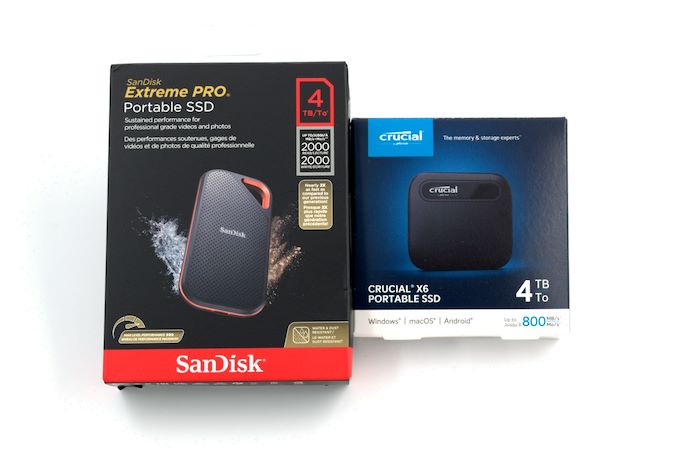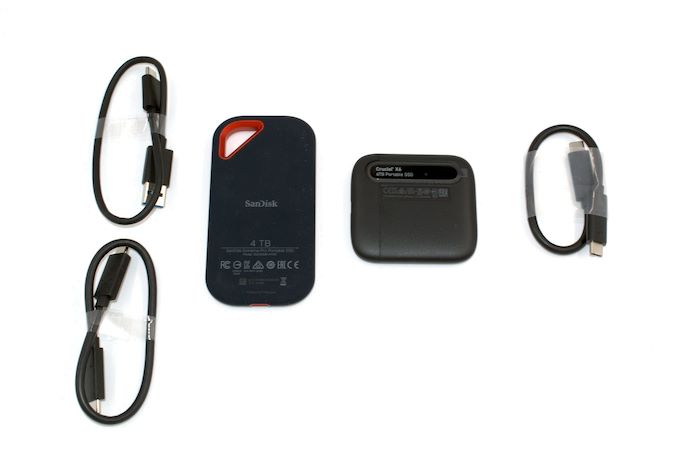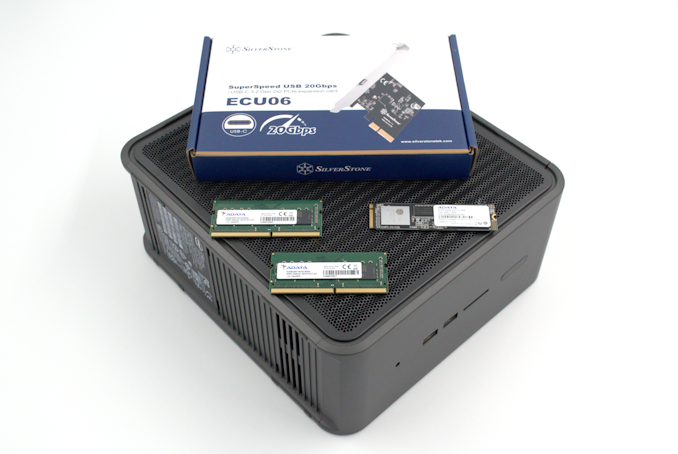SanDisk Extreme PRO and Crucial X6 4TB Portable SSDs Review: Contrasting High-Capacity Storage Options
by Ganesh T S on August 18, 2021 9:30 AM EST- Posted in
- Storage
- SSDs
- Western Digital
- DAS
- NVMe
- Type-C
- USB 3.2 Gen 2x2
- Portable SSDs

The portable SSD market has been steadily expanding thanks to the increasing digital footprint of consumers. Content creators find themselves capturing photos and videos at higher and higher resolutions and bit-rates, while gamers are encountering installation sizes running into 100s of GBs. And the backup requirements for the average consumer have also grown in tandem.
Meanwhile, technological advancements such as 3D NAND with high layer counts and the emergence of QLC have enabled SSD capacities to increase substantially over the last few years. With economies of scale kicking in, multiple vendors are finally able to offer consumer-focused flash-based storage devices in capacities up to 4TB. At the 2021 CES, Western Digital introduced 4TB variants of almost all drives in their portable SSD families, including their flagship SanDisk Extreme PRO v2 and the WD_BLACK P50 lines. In March, Crucial updated its affordable X6 lineup to include a 4TB version.
WD's flagships and Crucial's mainstream X6 offerings represent two ends of the pricing spectrum. At the same capacity point, they present an interesting view of the tradeoffs involved in achieving a particular price point - performance, consistency, BOM features, and value additions. This review looks at the features of the SanDisk Extreme PRO v2 4TB and the Crucial X6 4TB portable SSDs, along with an analysis of their performance numbers and value propositions.
Introduction and Product Impressions
External bus-powered storage devices have grown both in storage capacity as well as speeds over the last decade. While PCIe / NVMe has been the driver of SSD speeds, faster host interfaces (such as Thunderbolt 3 and USB 3.x) have helped on the direct-attached storage (DAS) side. We now have palm-sized flash-based storage devices capable of delivering 3GBps+ speeds. While those speeds can be achieved with Thunderbolt 4, mass-market devices have to rely on USB. Within the USB ecosystem, USB 3.2 Gen 2 (10 Gbps) is fast becoming the entry level for thumb drives and portable SSDs. Premium devices sporting the USB 3.2 Gen 2x2 (20 Gbps) interface have been making it to the market over the last 18 months or so, but have been held back by the lack of widespread host support in desktops and other computing platforms. In contrast, USB 3.2 Gen 2 (10 Gbps) has gained widespread deployment in both Type-C and Type-A versions.
The SanDisk Extreme PRO Portable SSD v2 4TB we are looking at in this review uses the same mainboard with the ASMedia ASM2364 brdige chip as the 2TB version reviewed in October 2020. The main update is in the capacity of the SN730E NVMe SSD used internally. Both capacities use the same 3D TLC NAND, with the increased capacities being enabled by flash packages on both sides of the M.2 SSD. It made sense for SanDisk to delay the launch of the 4TB version - waiting for the market demand to catch up, while also taking advantage of increased yields with the mature BiCS 4 fabrication process. In terms of package contents, IP rating, and the look and feel of the drive, there is no change from the version reviewed earlier.
Crucial has a long history of reusing product model names despite significant changes in the internals. The Crucial X6 Portable SSD 4TB also falls in the same category. We had reviewed the 2TB version last year with Crucial's QLC-based BX500 SATA SSD behind an ASMedia ASM235CM SATA-to-USB bridge chip. Crucial's X6 4TB is one of the first high-performance external SSDs to hit the market with a native USB flash controller. Essentially, it adopts a platform similar to the ones found on USB thumb drives. However, thanks to recent advancements, such controllers are now able to hit transfer rates up to 1.9GBps when configured with the appropriate NAND and upstream interface. The X6 4TB version uses Crucial's 96L 3D QLC with the Phison U17 controller. This combination enables Crucial to claim speeds of up to 800 MBps. Based on consumer reports, it appears likely that Crucial is replacing the SATA SSD / bridge chip configuration in the lower capacity X6 SKUs with the native flash controller based board.
A quick overview of the internal capabilities of the internal drives is given by CrystalDiskInfo.
| Internal Drive Information - CrystalDiskInfo | |
 |
 |
Both drives support S.M.A.R.T passthrough. X6 does not indicate TRIM as an available feature. However, we were able to activate TRIM in Windows on NTFS volumes in both drives. Temperature monitoring and obtaining health status (in terms of TBW) are simple for both drives.
The table below presents a comparative view of the specifications of the two portable SSDs covered in this review.
| Comparative Portable SSDs Configuration | ||
| Aspect | ||
| Downstream Port | 1x PCIe 3.0 x4 (M.2 NVMe) | Native Flash |
| Upstream Port | USB 3.2 Gen 2x2 Type-C | USB 3.2 Gen 2 Type-C |
| Bridge Chip | ASMedia ASM2364 | Phison U17 |
| Power | Bus Powered | Bus Powered |
| Use Case | Premium IP55-rated 2GBps-class, compact, and sturdy portable SSD in a gumstick form-factor | Affordable 800MBps, compact, and durable portable SSD in a pocketable form-factor |
| Physical Dimensions | 110.26 mm x 57.34 mm x 10.22 mm | 69 mm x 64 mm x 11 mm |
| Weight | 90 grams (without cable) | 41 grams (without cable) |
| Cable | 30 cm USB 3.2 Gen 2x2 Type-C to Type-C 30 cm USB 3.2 Gen 2 Type-C to Type-A |
24 cm USB 3.2 Gen 2 Type-C to Type-C Type-C to Type-A adapter sold separately |
| S.M.A.R.T Passthrough | Yes | Yes |
| UASP Support | Yes | Yes |
| TRIM Passthrough | Yes | Yes |
| Hardware Encryption | Yes (256-bit AES, only via SanDisk Secure App) | Not Available |
| Evaluated Storage | Western Digital SN730E PCIe 3.0 x4 M.2 2280 NVMe SSD SanDisk / Toshiba BiCS 4 96L 3D TLC |
Micron 96L 3D QLC |
| Price | USD 900 | USD 481 |
| Review Link | SanDisk Extreme PRO Portable SSD v2 4TB Review | Crucial X6 Portable SSD 4TB Review |
Prior to looking at the benchmark numbers, power consumption, and thermal solution effectiveness, a description of the testbed setup and evaluation methodology is provided.
Testbed Setup and Evaluation Methodology
The evaluation routine for direct-attached storage devices – portable SSDs, storage bridges (including RAID enclosures), and memory cards – all utilize the same testbed and have similar workloads with slight tweaks based on the end market for the product. Our testbeds have kept pace with the introduction of new external interfaces - Thunderbolt 2, Thunderbolt 3, and USB 3.2 Gen 2 via Type-C. In mid-2014, we prepared a custom desktop based on Haswell, which was then upgraded to Skylake in early 2016. A botched Thunderbolt 3 firmware upgrade on the Skylake machine meant that we had to shift to the Hades Canyon NUC starting in early 2019. This year, we have adopted the Quartz Canyon NUC (essentially, the Xeon / ECC version of the Ghost Canyon NUC) along with build components from ADATA Industrial - 2x 16GB DDR4-3200 ECC SODIMMs and a PCIe 3.0 x4 NVMe SSD - the IM2P33E8 1TB.
The most attractive aspect of the Quartz Canyon NUC is the presence of two PCIe slots (electrically, x16 and x4) for add-in cards. In the absence of a discrete GPU - for which there is no need in a DAS testbed - both slots are available. In fact, we also added a spare SanDisk Extreme PRO M.2 NVMe SSD to the CPU direct-attached M.2 22110 slot in the baseboard in order to avoid DMI bottlenecks when evaluating Thunderbolt 3 devices. This still allows for two add-in cards operating at x8 (x16 electrical) and x4 (x4 electrical). SilverStone's SST-ECU06 USB 3.2 Gen 2x2 (20 Gbps) add-in card (based on the ASMedia ASM3242 host controller) was installed in the x4 slot. The Type-C port from this add-in card is used to evaluate all storage devices with a USB 3.x interface.
The specifications of the testbed are summarized in the table below:
| AnandTech DAS Testbed Configuration | |
| System | Intel Quartz Canyon NUC9vXQNX |
| CPU | Intel Xeon E-2286M |
| Memory | ADATA Industrial AD4B3200716G22 32 GB (2x 16GB) DDR4-3200 ECC @ 22-22-22-52 |
| OS Drive | ADATA Industrial IM2P33E8 NVMe 1TB |
| Secondary Drive | SanDisk Extreme PRO M.2 NVMe 3D SSD 1TB |
| Add-on Card | SilverStone SST-ECU06 USB 3.2 Gen 2x2 Type-C Host |
| OS | Windows 10 Enterprise x64 (21H1) |
| Thanks to ADATA, Intel, and SilverStone for the build components | |
The evaluation scheme for DAS units involves multiple workloads which are described in detail in the corresponding sections.
- Synthetic workloads using CrystalDiskMark and ATTO
- Real-world access traces using PCMark 10's storage benchmark
- Custom robocopy workloads reflective of typical DAS usage
- Sequential write stress test
While most DAS units targeting a particular market segment advertise similar performance numbers and also meet them for common workloads, the real differentiation is brought out on the technical side by the performance consistency metric and the effectiveness of the thermal solution. Industrial design and value-added features may also be important for certain users. The remaining sections in this review tackle all of these aspects.












20 Comments
View All Comments
eastcoast_pete - Wednesday, August 18, 2021 - link
I find it unfortunate that neither manufacturer found a way to integrate at least a few inches/centimeters of cable with USB connector into the case. You could still have another port/connector for an actual cable, but having let's say 6 inches/ 15 cm of cable with plug always attached (cable stored in a groove around the case) avoids the situation when one really needs to back up or save some larger files in a pinch, but then the cable is MIA. That's one of the reasons why USB sticks are so handy (can't lose the connector, you either have the stick or you don't), but they don't reach the speed or capacity of these external SSDs. Replydamianrobertjones - Wednesday, August 18, 2021 - link
cables can snap off, break etc. Then again so can the connector. I'd rather buy x3 cables for a sensible price. one at work, one at home, one to travel. Replymeacupla - Wednesday, August 18, 2021 - link
ew, no, that's disgustingIntegrated cable is easily the worst and cheapest way to design things. Cables are, easily, the most likely connection to fail, and you want to integrate that?
The only thing worse is a micro USB3.0 connector
USB 3.0 A or USB-C, male, with a dust cover is an acceptable alternative, but female USB-C connector is so convenient, why would you use anything else? Reply
flyingpants265 - Wednesday, August 18, 2021 - link
Integrate a removable cable. Problem solved. Replywatersb - Wednesday, August 18, 2021 - link
Better: integrate a microUSB 3.0 cable. Now you have two problems. Replywhatthe123 - Wednesday, August 18, 2021 - link
or you could just have a slot for the removable cable instead of adding another point of failure Replyaparangement - Wednesday, August 18, 2021 - link
I think thermal capacity is the major bottleneck. You either live with slow USB stick which is cool and light, or PSSD with seperate cable, since the increased weight makes the connector more vulnerable. ReplySivar - Wednesday, August 18, 2021 - link
It seems both products are priced reasonably. It's rare that I really need a portable drive to be Tesla quick, so I think the Crucial drive is a great deal for me, perhaps for most people. Replyevanh - Wednesday, August 18, 2021 - link
The X6 fails in the sequential bulk copy dept. That's a primary use case for external storage devices. Replyganeshts - Friday, August 20, 2021 - link
It performs great for up to 800GB of continuous traffic. Can't imagine a casual user transferring that much amount of data in one go. As I mentioned in the concluding section, power users with such demanding requirements have to be ready to fork out a premium for the full-capacity consistency that the SanDisk Extreme PRO v2 provides. Reply